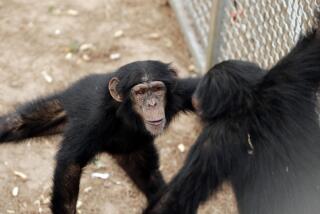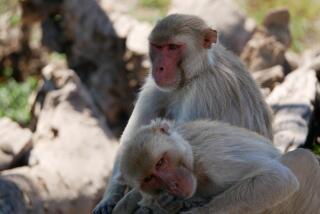Bonobos Make Love, Not War
- Share via
Scientists have long sought clues about human behavior by studying our closest animal relative, the chimpanzee. That has been discouraging at times, because chimp society offers a bleak view of the struggle for survival. There are gangs of aggressive males, occasional infanticide, the rape and beatings of females and fierce, sometimes lethal, competition for food, sex and territory.
But a different branch of our primate family tree demonstrates the flip side of the natural-selection coin. The bonobo, an elusive ape living in rain forests of Congo, offers an intriguing alternative to the chimps’ male-based model of human evolution--just the thing for this post-feminist era.
Bonobos (pronounced bo-NO-bo) are graceful, egalitarian and largely pacific. Like chimps, bonobos have DNA that is 98% identical to humans’. They draw social rank from their mothers’ status. Powerful female alliances protect against infanticide and male bullying of females and enable females to feed before males.
With the exception of hyenas and the lemurs of Madagascar, mammals are male dominated, says Frans de Waal, an internationally renowned primatologist at Emory University in Atlanta.
“Bonobos never needed the feminist revolution because probably for thousands of years females have been dominating males,” De Waal writes in “Bonobo: The Forgotten Ape” (University of California Press, 1997), the first profile of the bonobo written for a general audience.
Best known as the “sexy” primate, bonobos “act as if they had read the Kama Sutra,” says De Waal, who based his book upon studies of bonobos in captivity (there are only 100, including colonies at the San Diego Zoo and San Diego Wild Animal Park) and in the wild where they are vulnerable to extinction because of habitat encroachment.
Sex is the bonobos’ social currency. Friction is eased with a quick orgy in which the bonobo, like a sexual acrobat, uses every imaginable form of erotica including fondling, masturbation, homosexual sex and face-to-face copulation.
“Bonobos have perfected the art of female alliances and found a solution to infanticide. Once you have gone that far, why not go all the way?”
Ecologically speaking, bonobo female alliances are possible because ground vegetation is plentiful, effectively eliminating competition for it. Among chimps, De Waal says, females are forced to be loners, foraging for scarce food in competition with bands of male chimps (that align themselves by male kin) and with gorillas.
The female bonobo operates from more of a feminist world order, cooperating to keep bully males in line and attacking or injuring lower-ranking males that turn aggressive. Unlike male chimps that gain rank by size and brute force, female bonobos gain “influence” and rank based upon a sort of “age before beauty” model:by seniority and group affection.
“If you have a fully grown adult female with offspring, there is no way males are going to dominate her,” De Waal says. “At one point, the Milwaukee Zoo had three males who were much bigger than a female named Maringa and she dominated all of them.”
Female chimps and bonobos both leave their natal group to avoid inbreeding, but bonobos “bond” with a “secondary sisterhood,” a group of females to which they are unrelated.
A male bonobo has a lifelong relationship with his mother: nursing until age 4, riding her piggyback to age 6, hanging out with her for life in a coed group and drawing her into his battles. If she dies, he can lose rank.
“Some human males would call them crybabies,” quips De Waal. “Male bonobos really don’t fit the human male ideal. It is possible we can redeem them. . . . There is some vague indication that males have some effect over which way the group travels.”
While De Waal stops short of dubbing the bonobo the “make love, not war primate,” he says undoubtedly “sex is the glue of bonobo society.” Once called the “sex champion of the primate world,” bonobos in captivity engage in sexual activity an average of every 90 minutes (wild bonobos are probably less active, he says). And a little sex goes a long way. It promotes sharing, negotiates favors, initiates females into the sisterhood and generally calms nerves.
Where neighboring chimp communities rarely interact except aggressively, neighboring bonobo communities forge friendships through sexual liaisons, initiated first by females to males and then by females to females (that often prefer each others’ company to males’).
“When two groups meet, there is a lot of noise by males and a high level of tension and hostility, but they don’t attack like chimps,” De Waal says. “Tension is soon overruled by sex and friendship. The scene ends with the females of different communities grooming each other and adolescents and children playing together.”
But lest one think the bonobo is a paragon of sensitivity and feminist utopia, De Waal cites occasional bouts of nasty physical aggression. Females at the Frankfurt Zoo in Germany occasionally held down a male and attacked him, biting off parts of fingers and toes, according to one anthropologist’s observations. Another female that had constantly attacked a male at the Stuttgart Zoo in Germany was believed to be the culprit responsible for biting his penis almost in half (vets were able to reattach it). A high rate of physical abnormalities in males in the wild at Wamba, Congo, may also partially stem from female aggression.
Still, there are no documented cases of lethal aggression, cannibalism or infanticide among bonobos, as there are among chimps.
“This is real dominance,” De Waal says. “You are much more likely to see females chasing males. Females do this because males have no effective way to stand up to them. Why is it that male bonobos are unable to stand up for each other? Maybe they get something out of it . . . or they actually enjoy themselves.”
As one feminist science writer reportedly said: “The bonobo is the only hope!”
Looking for our inner bonobo can help us squelch the myth of the killer ape and man as innately aggressive, De Waal says. Human nature is not a stereotype, he warns. The bonobo suggests that we have probably underestimated the biological flexibility of our lineage as a species.
“We want to believe that we are either the noblest of creatures or the most aggressive killers,” De Waal says. “But basically we are both. You have three species which are so closely related but very different. All these qualities are present in a single species but in a different balance.”





